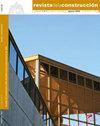钢筋混凝土塔的试验与数值动力辨识
IF 1.4
4区 工程技术
引用次数: 0
摘要
在本研究中,研究了伊斯坦布尔的一个重要结构,Üsküdar观察塔(UOT)的动力性能。塔的结构体系由外径2.8米、厚度40厘米的钢筋混凝土圆管构成。从地面上看,由于塔周围有五层地下室,它从-18.2米开始,高度为44米。两个钢筋混凝土地板部分悬空,高度分别为36米和40米。该塔楼与地面层有独立的结构系统,但非结构包层组件将其与建筑群中的相邻建筑连接起来。基于上述结构特征,利用环境振动测量(AVS)技术,采用峰值拾取(PP)方法获取UOT的动态特性。结合UOT的特点,讨论了所得的动力学性质。虽然进行的分析揭示了相邻建筑和地下楼层在UOT动力行为中的无效,但楼层的扭转作用已被注意到。建立了数值模型,通过有限元分析获得了UOT的动态特性。模型校正需要将混凝土的基于代码的弹性模量提高23%,以配对实验和数值动态特性。讨论了AVS增大的原因以及AVS与FEA的相关性。本文章由计算机程序翻译,如有差异,请以英文原文为准。
Experimental and numerical dynamic identification in an RC tower
In this study, the dynamic behavior of one of the prominent structures in Istanbul, Üsküdar Observation Tower (UOT) has been investigated. The structural system of the tower is formed by a reinforced concrete circular tube having 2.8 meters outside diameter with a 40 centimeter thickness. By referring to the ground level, it starts from -18.2 meter due to five basement stories around the tower and its height is 44 meters. Two reinforced concrete floors were partially hanged over at 36 meter and 40 meter in height. The tower has an independent structural system from the ground level but a non-structural cladding assembly connects it to an adjacent building in the complex. With the mentioned structural features, Ambient Vibration Survey (AVS) was utilized to obtain the dynamic characteristics of UOT by Peak Picking (PP) method. The obtained dynamic properties were discussed with the peculiarities of UOT. While the performed analysis revealed the ineffectiveness of the adjacent building and the underground stories in the dynamic behavior of UOT, the torsion action of the floors has been noted. A numerical model has also been constructed to obtain the dynamic characteristics of UOT by Finite Element Analysis (FEA). The model calibration required to increase the code-based modulus of elasticity of the concrete by 23% for pairing the experimental and numerical dynamic properties. The reasons of the increase and the correlation between AVS and FEA were discussed.
求助全文
通过发布文献求助,成功后即可免费获取论文全文。
去求助
来源期刊

Revista de la Construccion
工程技术-工程:土木
CiteScore
2.30
自引率
21.40%
发文量
0
期刊介绍:
The Journal of Construction is aimed at professionals, constructors, academics, researchers, companies, architects, engineers, and anyone who wishes to expand and update their knowledge about construction. We therefore invite all researchers, academics, and professionals to send their contributions for assessment and possible publication in this journal. The publications are free of publication charges.
OBJECTIVES
The objectives of the Journal of Construction are:
1. To disseminate new knowledge in all areas related to construction (Building, Civil Works, Materials, Business, Education, etc.).
2. To provide professionals in the area with material for discussion to refresh and update their knowledge.
3. To disseminate new applied technologies in construction nationally and internationally.
4. To provide national and foreign academics with an internationally endorsed medium in which to share their knowledge and debate the topics raised.
 求助内容:
求助内容: 应助结果提醒方式:
应助结果提醒方式:


